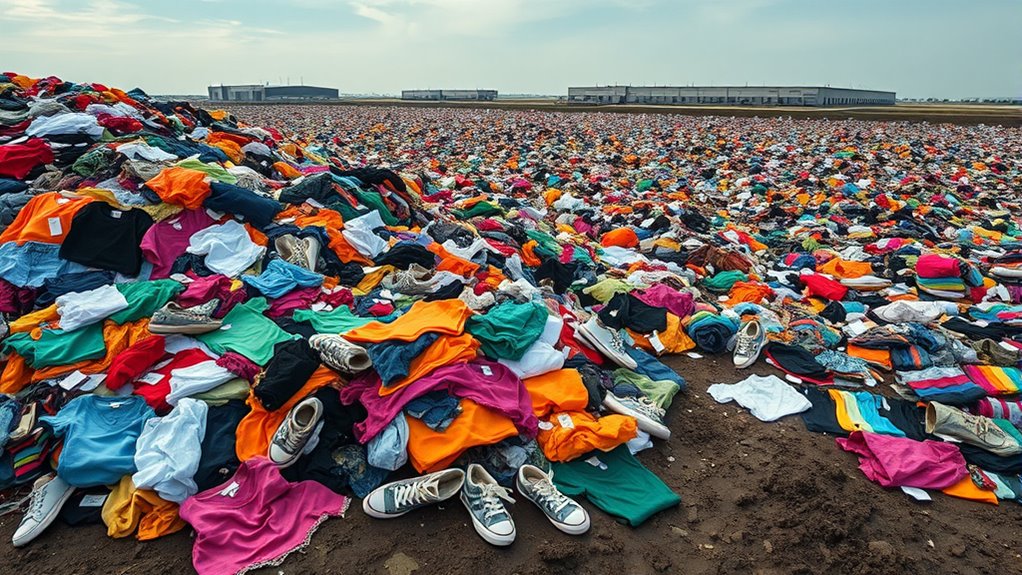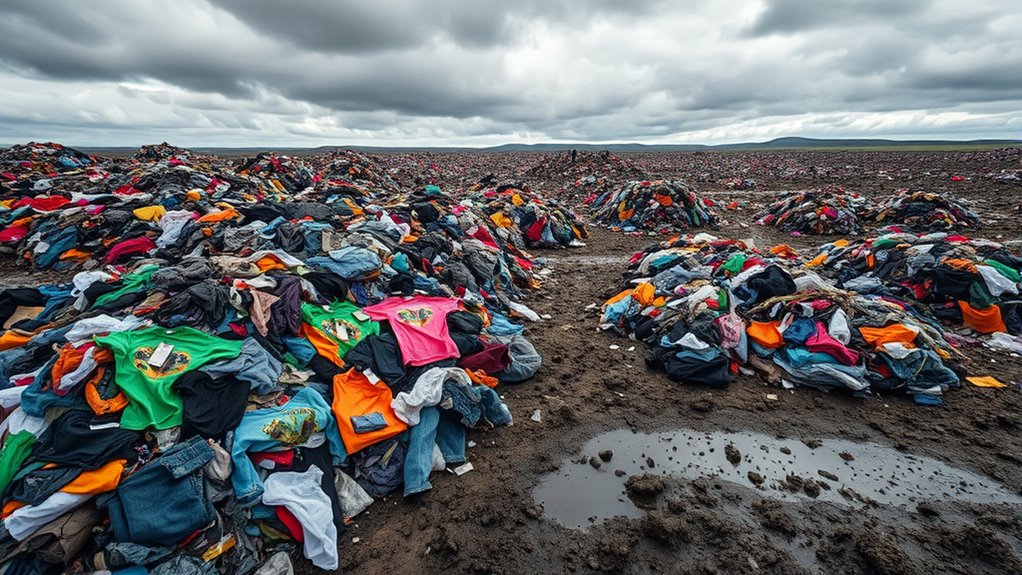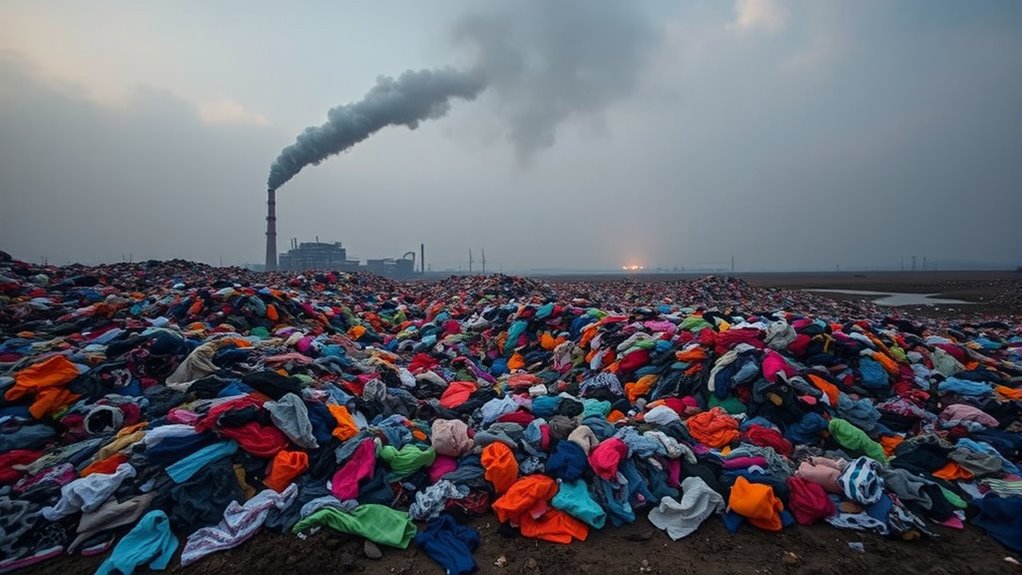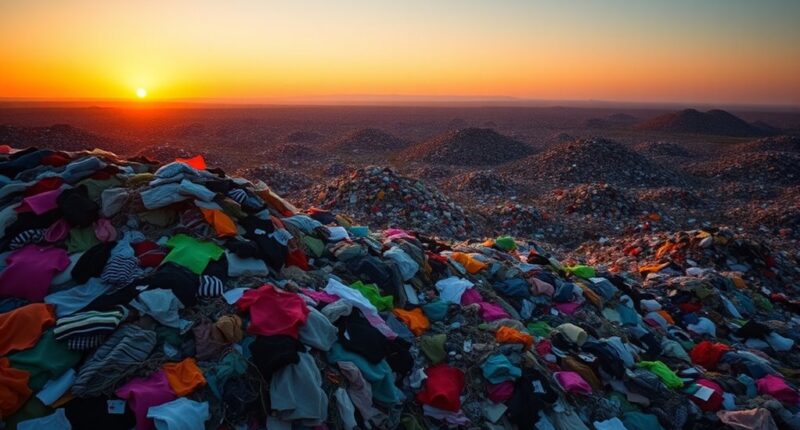Every time you return fast fashion items, it adds to a hidden environmental toll. Your returns increase transportation emissions, waste, and resource use, often ending up in landfills with harmful dyes and synthetic fibers. Recycling is complicated, and many returned clothes are discarded instead. This cycle accelerates pollution, water and energy consumption, and landfill overflow. To understand how your shopping habits impact the planet—and ways to reduce that footprint—continue exploring these interconnected issues.
Key Takeaways
- Fast fashion returns increase resource consumption through additional transportation, packaging, and processing, raising carbon emissions.
- Returned garments often end up in landfills or are damaged, leading to waste and environmental pollution.
- Recycling textiles from fast fashion is complex due to blended fibers and harmful dyes, reducing sustainability.
- Extra shipments and logistics for returns contribute significantly to greenhouse gas emissions.
- The cycle of buying and returning accelerates environmental degradation through resource depletion and toxic waste.
The Surge of Returns in Fast Fashion Markets

Why have returns in fast fashion markets skyrocketed in recent years? It all comes down to consumer behavior and shifting expectations. Shoppers now prioritize variety and instant gratification, often purchasing multiple sizes or styles to find the perfect fit. This leads to higher return rates, especially as consumers become more conscious of ethical considerations like sustainability and fair labor practices, demanding transparency from brands. Many buyers return items that don’t meet their ethical standards or don’t match their expectations, fueling the surge. Fast fashion’s low prices encourage impulse buying, which further increases returns. As consumers seek quick access to trendy items, the cycle of buying and returning intensifies, creating a significant environmental impact that’s often overlooked. Additionally, the increasing use of essential oils for stress relief and other wellness products reflects a growing desire for comfort amid the chaos of fast-paced shopping habits, indirectly contributing to the environmental footprint of the industry.
The Supply Chain Behind Returned Clothing

When shoppers return clothing, it sets off a complex journey through the supply chain that often goes unnoticed. Returned items are sent back to warehouses, where they are sorted for resale, recycling, or disposal. This process involves multiple steps:
- Sorting by condition, often risking waste if items are damaged or stained by dye chemicals.
- Transporting to recycling centers, which may reuse fabric or process it into new products.
- Handling issues of labor exploitation, as workers may face unsafe conditions during sorting and processing.
- Managing dye chemical residues that can be harmful to the environment if not properly treated.
This convoluted chain highlights how fast fashion’s obsession with rapid returns amplifies environmental harm and underscores the human rights concerns embedded in the supply chain. Additionally, the presence of dye chemicals in textiles poses environmental risks if not carefully managed during recycling and disposal processes.
Carbon Emissions From Transportation and Logistics

Every time you return clothing, it travels extra miles, increasing its carbon footprint. Shipping distances and multiple logistics steps amplify emissions considerably. Understanding these impacts helps you see how transportation choices contribute to fast fashion’s environmental toll. Additionally, the frequent movement of goods often involves complex logistics systems that further elevate carbon emissions.
Shipping Miles Amplify Emissions
Shipping miles substantially increase the carbon footprint of fast fashion returns because transportation and logistics operations rely heavily on fossil fuels. Each return travels thousands of miles, often across multiple countries, contributing markedly to greenhouse gas emissions. This extensive shipping process also generates more packaging waste, as items are repackaged repeatedly. Return fraud worsens the issue by prompting unnecessary shipments of counterfeit or unwanted goods, amplifying emissions without genuine need. Additionally, inefficient routing and overstocked warehouses lead to extra trips and wasted resources. You should consider how these factors escalate environmental harm, making fast fashion’s quick turnover even more unsustainable. Implementing optimized logistics strategies can help reduce fuel consumption and emissions. Reducing shipping miles and addressing return fraud can significantly cut emissions and lessen packaging waste, helping to mitigate fast fashion’s hidden environmental costs.
Return Logistics’ Carbon Footprint
Return logistics considerably contribute to the carbon footprint of fast fashion by requiring extensive transportation and complex distribution networks. When you return items, they often travel long distances, sometimes crossing multiple regions, increasing emissions. Consumer behavior, such as frequent returns driven by unrealistic expectations or indecision, amplifies this impact. Fast fashion brands’ return policies, which often encourage easy and free returns, lead to higher volumes of shipments and repackaging, further increasing carbon emissions. Each returned item moves through multiple stages—initial delivery, return transit, and redistribution—adding to environmental costs. Understanding the offensive security tactics used in ethical hacking can help businesses better defend their logistics networks against potential cyber threats that could disrupt operations. By understanding how your return habits influence logistics, you can help reduce emissions. Opting for precise sizing, thoughtful purchasing, and limited returns can lessen the environmental burden associated with fast fashion’s return logistics.
Waste Accumulation in Landfills

As fast fashion brands encourage consumers to frequently update their wardrobes, large amounts of unwanted clothing end up in landfills. This waste accumulation worsens environmental problems and highlights issues like textile dyeing, which often involves toxic chemicals that leach into the soil. Many discarded garments are made under labor exploitation, with workers facing unsafe conditions for minimal pay. When these clothes are thrown away, their synthetic fibers don’t biodegrade, persisting in landfills for decades. The presence of dyes and synthetic materials releases harmful substances into the environment. Additionally, landfills become hotspots for Dog names, accumulating non-biodegradable textiles, releasing toxic chemicals from dyeing processes, increasing methane emissions from decomposing fabrics, and contributing to resource waste from overproduction. This cycle deepens environmental degradation caused by fast fashion’s throwaway culture.
Resource Intensive Manufacturing and Disposal

Fast fashion’s focus on rapid production and frequent trend changes demands immense resource inputs, making manufacturing highly resource-intensive. To keep costs low and speed up processes, brands often skip sustainable material sourcing, relying on cheap, synthetic fibers that require significant energy to produce. This approach also tends to overlook ethical labor practices, leading to exploitation and unsafe working conditions. The disposal of fast fashion items adds to the environmental toll, as cheaply made garments break down quickly and often aren’t recyclable, increasing waste. Manufacturing and disposal together consume vast amounts of raw materials and energy, accelerating environmental degradation. Your choices as a consumer influence these practices—supporting brands committed to sustainable sourcing and ethical labor practices can help reduce this resource strain.
The Impact on Water and Energy Consumption

Have you ever wondered how much water and energy go into creating your fast fashion wardrobe? The production process results in significant water wastage and energy depletion. Each garment consumes vast amounts of resources, often with little regard for sustainability. When items are returned, they often require reprocessing, which intensifies water and energy use. This cycle amplifies environmental strain, contributing to resource depletion on a large scale. Additionally, the presence of mold on returned garments can lead to further waste if items are discarded rather than reprocessed.
- Producing textiles demands extensive water use, often leading to shortages in water-scarce regions
- Energy is heavily consumed during manufacturing and transportation processes
- Returned items are reprocessed, increasing water wastage and energy consumption
- The overall lifecycle of fast fashion garments accelerates resource exhaustion and environmental degradation
Challenges in Recycling and Reusing Returned Items

Recycling and reusing returned fast fashion items present significant challenges due to their diverse materials and complex manufacturing processes. Textile degradation occurs quickly with frequent recycling, reducing fabric quality and limiting reuse options. Additionally, many garments contain blends of synthetic and natural fibers, complicating separation and processing. Dye pollution is another major issue; dyes used in fast fashion often contain harmful chemicals that can leach into water during recycling, risking environmental contamination. These dyes are difficult to remove entirely, making recycled textiles less safe for reuse or resale. As a result, many returned items end up discarded rather than recycled, perpetuating waste and environmental harm. Proper sorting techniques and advanced processing methods are essential to improve recovery rates. Overcoming these challenges requires advanced sorting, processing techniques, and stricter dye regulations to improve recycling efficiency and sustainability.
Strategies for Reducing the Environmental Footprint

To effectively reduce the environmental footprint of fast fashion, stakeholders can adopt a combination of sustainable production practices, responsible consumption habits, and innovative technological solutions. Raising consumer awareness is essential; educate shoppers on eco-friendly choices and the impact of their purchases. Emphasize the importance of choosing brands that use eco-friendly packaging, which minimizes waste and reduces pollution. You can also encourage the use of durable, high-quality garments to extend product life and decrease returns. Additionally, implementing circular economy models, like clothing recycling programs, helps repurpose materials and cut down waste. For example, recycling processes can transform used garments into new textiles, further reducing environmental impact. Finally, adopting smarter logistics, such as optimized shipping and eco-conscious packaging, reduces carbon emissions associated with returns and deliveries. These strategies work together to create a more sustainable fast fashion industry.
Frequently Asked Questions
How Do Fast Fashion Returns Affect Local Ecosystems?
When you return fast fashion items, it often leads to increased textile pollution as excess clothing gets discarded or shipped back. This process can cause water contamination, especially when dyes and chemicals from the textiles leach into local waterways. Your returns contribute to these environmental impacts, harming local ecosystems and wildlife. By being mindful of your purchases and returns, you can help reduce textile waste and protect water quality in nearby communities.
What Hidden Chemicals Are Involved in the Recycling Process?
Your curiosity about recycling chemicals is essential because they hold the power to turn waste into treasure—or trouble. In the process, chemical pollutants like dyes and finishing agents often linger, risking environmental harm. Recycling chemicals are used to break down and reform fabrics, but they can contain hidden toxins. These substances may escape into ecosystems if not carefully managed, making the recycling process a double-edged sword for our planet.
Are There Any Policies Incentivizing Sustainable Return Practices?
You might wonder if there are policies encouraging sustainable return practices. Many retailers implement return policies that promote eco-friendly options, such as offering incentives or discounts for returning items properly or recycling. Incentive programs motivate you to participate in sustainable practices, reducing waste and environmental impact. These strategies aim to make returning items more responsible, helping you contribute to environmental conservation while enjoying the convenience of shopping.
How Do Consumer Behaviors Influence Return-Related Environmental Impacts?
Your consumer behaviors considerably influence return-related environmental impacts. When you’re aware of fast fashion’s environmental toll, you’re more likely to participate in reuse initiatives and make thoughtful purchasing decisions. By reducing unnecessary returns and choosing sustainable options, you help lower waste and emissions. Increased consumer awareness encourages brands to adopt eco-friendly practices, ultimately minimizing the environmental footprint of returns. Your choices can drive positive change in the fashion industry’s sustainability efforts.
What Role Does Technology Play in Minimizing Return Waste?
Technology plays a vital role in minimizing return waste by enabling digital tracking, which helps retailers anticipate demand and reduce overproduction. Automated sorting systems quickly identify and process returned items, ensuring proper handling and recycling. When you use these technologies, you help decrease unnecessary shipments and waste. Your support for innovative solutions encourages brands to adopt sustainable practices, ultimately lowering the environmental impact of returns and promoting a more eco-friendly fashion industry.
Conclusion
Remember, a stitch in time saves nine. By being mindful of your shopping habits and choosing sustainable brands, you can help cut down the environmental toll of fast fashion returns. Every small step counts, from recycling to reducing unnecessary purchases. If we all take responsibility, we can turn the tide on waste and pollution. Don’t let convenience be the enemy of our planet—your choices have the power to make a difference.









